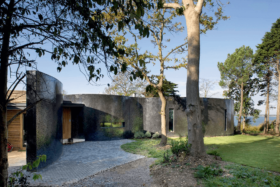

For eco-conscious self-builders, creating a super-efficient Passivhaus can yield a raft of benefits – including lower energy bills. I recently chatted to James Henderson, senior architect at RDA Associates, about the benefits of the Passivhaus approach to designing and building homes. Here’s what he had to say:
From a client point of view, eco-houses are in the public domain now and knowledge of the Passivhaus approach is creeping in too. Magazines and TV shows are some people’s sole source of knowledge on this kind of construction, but this greater awareness means it’s growing in popularity with self-builders. Councils are also starting to recognise this method of building as well, and the more people that do it the more word of mouth spreads.
The beauty with the Passivhaus ideology is that it’s designed by a physicist – Professor Wolfgang Feist – and that’s what gives the system its kudos. Once you input all the relevant figures about a project you can be certain of what your outcome is going to be – and that’s a dwelling that gets rid of all the draughts and controls internal air quality.
The problem with some of the other eco-assessment measures is that you don’t get the same level of assurance, and therefore you end up with a setup that might not be working as effectively as it could. Of course, you can get various benefits from installing various kinds of eco-bling, but what you get with Passivhaus is the longevity of the product that you’ve designed.
Opting to take this approach means you’re going to save money on heating in the long term – so it’s not just the initial investment that should be considered. Another thing you get is credibility, because you’ve got a certified Passivhaus property which is going to perform to the same standard for the next 30-odd years at least, based on the fact that it’s a proven system. You’re getting something that’s like a kitemark, as it’s been designed, tested and constructed with rigor.
If you’re creating a dwelling from scratch then you’re approaching the project with a big advantage because you can maximise the energy from the structure’s surroundings. The challenge we’ve encountered with self-builders in the past is that they’ve bought their plot, obtained planning permission for a specific scheme and then decided they want to make it Passivhaus.
It’s better to be thinking about this set of principles from the outset so you can maximise the potential of the site and the surrounding characteristics like orientation, shading and the unique features of the landscape.
A lot of people want a house that’s environmentally-friendly, and the interest in Passivhaus is something that tends to develop as the scheme progresses. Most individuals will approach us because they like our style, which is very minimal and contemporary. We certainly get those that’ve heard about Passivhaus, so they’re keen to learn what it is, if it’s something they should be doing and whether they can achieve it with the house or plot they’ve got.
The great thing to come in is the retrofit standards. For example, people living in old Victorian or Georgian houses are cold and they’re spending a lot of money on heating, so they recognise that increasing the thermal performance of their homes can help them save money.
Ultimately, once clients hear about the thermal advantages, the health benefits of improved air quality and the fact that it doesn’t cost extra, that’s when the scales start tipping. We try and get the decision of whether or not to go down the Passivhaus route made early on so we’re able to make the design as efficient as possible.
You can, but we’re talking about a proven accreditation that’s been designed by a physicist to do a specific job. You’re only going to achieve that level of thermal efficiency and internal air quality by going down this route. Building Regulations stipulate that you need to have less than 10 air changes per hour in a new build – Passivhaus is 0.6. An energy-efficient building could have three air changes per hour, for instance, but there’s still a big difference between that and Passivhaus.
Another factor that sets Passivhaus apart is the careful installation. Everything on site has to be super clean to minimise the risk of ripping through any building materials that could ultimately cause an air leak. For any project we’re on site weekly, if not more – especially if it’s a Passivhaus scheme. It’s important to keep an eye on what’s going on and check the critical stages. This level of attention when it comes to construction is something you don’t get with a regular eco house.
No, and what we’re proving as a practice is that you can get really amazing designs for these kinds of homes. Some people have the preconception that if you build an eco-friendly house it’s going to be green and hairy. However, there are plenty of architects out there that are challenging this view.
Of course, there’s going to be certain elements we’ll need to integrate into the design to make it a Passivhaus, and that might be the orientation or size of the windows, but ultimately we’re going to make the structure look as beautiful as we can to achieve the desired aesthetic and performance.
Yes – 100% – because it’s the only way you can guarantee that you’ve got a Passivhaus. You can still work on the calculation spread sheets and maybe get onto site, but if your architect isn’t monitored or if their calculations were incorrect to begin with, you’re not going to get a building that performs as it should. If you have a Passivhaus that’s not been accredited then it doesn’t mean anything – you can’t be certain if the building meets all the requirements or that it’s functioning in the way it ought to.
When you get the property certified, what you’re paying for is for a consultant assessor to give you the final stamp of approval. The fee for that is in the £100s, which is a fraction of a percent of the whole build cost. It’s completely worth doing as it ultimately gives you peace of mind.
If you’re self-building and contemplating going down the Passivhaus route, it’s best to have this in mind from day one. That way you can take factors such as the orientation of the plot and overshadowing into account when you buy it. While that’s not a luxury everyone has got, if it comes down to a choice of two sites, one could be much more suited to building this kind of home.
It’s worth doing your homework as well – don’t be put off because you heard the myth that you need to keep the windows closed or that the ventilation fans are noisy. There’s so many bodies of work that have gone into making this system what it is. We live in a world where fuel poverty is a real thing and the general cost of living is constantly increasing. If you can design houses that are going to reduce your energy consumption and result in cheaper bills, why wouldn’t you?
With every year that passes, word is spreading more. The industry is promoting itself better and the public has more access to literature that’s covering this approach to construction. The quicker people catch on that this is a way of building that will improve the quality of the dwelling and its internal environment, the more people that’ll do it.
It’s a really great industry as well – no one is fighting against each other to try and get business. Actually, people are really keen to co-operate so we’re better able to educate clients about the benefit of Passivhaus. There’s been an amazing enthusiasm for it because people know it’s a system that works.

